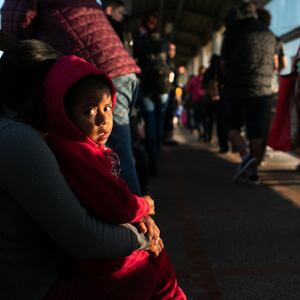“So they’re going to get away with it?” my wife asked me recently with a mix of anger and resignation in her voice. “Whatever happened to that story? It just disappeared.”
“They” are the U.S. border patrol agents, guards and supervisors who manage–or who have managed in recent years–those notorious U.S. government-funded detention facilities that house migrant and refugee children. They take custody of these children, often having separated them from their parents. So they act in loco parentis (in place of parents), and assume responsibility for the welfare of these minors.
“It” are the more than 4,500 complaints about alleged physical and sexual abuse of migrant and refugee children in these kinds of detention facilities that the federal government received over a period of four years, as revealed by the Justice Department last February (PDF). The abuse is alleged to have surged when the Trump administration implemented its cruel and ill-conceived policy of separating families at the U.S.-Mexico border to deter others from coming.
ADVERTISEMENT
That’s not surprising. Without their parents to watch over them, these children were left at the mercy of law enforcement officers who have little training in how to deal with children. Worse, some of these officers may have had sadistic tendencies that made them the last people on Earth who should have been put in charge of running a day care.
The “story” is centered around claims that adult staff members harassed and assaulted children, fondled and kissed them, watched them shower, and even raped them. There are also allegations that some of the children were abused by other children, and that adults who were supposed to be in charge were aware that this was happening.
Just when you thought the daily news couldn’t get more nauseating, along comes a story to prove you wrong. It wasn’t bad enough when we learned, a few years ago, that as the result of the Trump administration’s spiteful plan to separate families, Uncle Sam was a glorified kidnapper on a mass scale. Now we find out that the old guy is accused of being a child molester.
My wife, who was born in Mexico and came to the United States legally as a child, is right that this story has largely disappeared. It’s difficult to find any information about what has happened as a result of these startling revelations last year by our own government.
What investigations are underway? Who has been arrested, prosecuted, or otherwise held to account for these alleged atrocities? So far, the answer is nobody.
As a mother of three herself, my wife is naturally disgusted by every aspect of this story. It makes her skin crawl. In fact, it’s more than that. She’s filled with rage. And, believe me, as a Mexican woman, she rages well.
But, as an immigrant who grew up south of the U.S.-Mexico border with an up-close view of a corrupt and dysfunctional government that helps the powerful prey on the vulnerable, she’s not at all surprised.
Not by the fact that these terrible things may have happened, or that so many Americans either don’t know or don’t care that they are alleged to have happened in their name. If anything, the ease with which Americans brush past disturbing headlines that just a few years ago would have stopped them in their tracks only confirms for her what she has long suspected: that the country she arrived in four decades ago isn’t much better than the one she left behind.
If I’m being honest, I’m also not surprised that a story about the alleged abuse of thousands of children in U.S. custody can’t seem to get much traction. For me, it’s not about hatred or distrust of government.
Instead, there are at least three reasons that a story like this tends to fade from public view.
First, it’s not black-and-white. I’m not speaking metaphorically. I’m talking about color schemes. Here we have a story about children from Mexico and Central America who were allegedly abused in U.S. detention facilities. Those facilities are run and supervised by personnel from Customs and Border Protection, principally the Border Patrol, an agency that is, according to recent statistics, more than 50 percent Latino. As such, the story doesn’t fit neatly into the paradigm that Americans feel most comfortable with—that of a white law enforcement officer who is accused of abusing a black suspect.
Second, these are children we’re talking about, and they’re also migrants and refugees. These are populations that don’t vote or join unions or even riot in the streets, and so they’re often overlooked and forgotten. They’re treated as afterthoughts. The reason there is a “Children’s Defense Fund” and not an “Adult’s Defense Fund” is that, generally speaking, adults can take care of themselves. Migrants and refugees are easily preyed upon because they have to contend with the fact that the United States is a land built by foreigners that doesn’t like foreigners–and never has.
And third, Americans only have so much moral bandwidth to offer. With so many terrible things happening these days–from a global pandemic that has claimed more than 100,000 American lives to police violence to riots and looting in the streets—it can sometimes seem as if the "terribles" are competing not just for our attention but also for a slice of our humanity. It’s easy to feel overwhelmed, and to just let the latest terrible thing wash over you. That’s not the same as condoning the horror, we tell ourselves. Or is it? Either way, you know the headline is dreadful. But you glance at the story and turn the page.
That’s how it has always been. But I’m sorry, that’s not good enough anymore. It’s a new day in America, remember? A day of reckoning, where public institutions are finally held accountable for their wicked deeds.
We can’t let this story die. We have to keep pushing the Trump administration, Congress, and anyone else we can think of to get to the bottom of what’s been happening to children in U.S.-run detention facilities. There need to be investigations, prosecutions, convictions, and jail time for the offenders. Those who may have crossed the line in this instance and preyed on the weak have to be brought to justice in a very public way that makes an example out of them. The whole country needs to know what happened and come away with some assurances that it’ll never happen again.
It’s a matter of decency, but it’s also a matter of principle. We can’t be a country of protesters who go around chanting “Black Lives Matter” while police unions chant “Blue Lives Matter,” and then we all treat brown children as if their lives don’t matter. If there are any lessons Americans should be learning from current events, it’s that evildoers who abuse their power have to be brought to justice and ignoring abuse and mistreatment is a prescription for disaster.
“They” cannot be allowed to get away with this.






